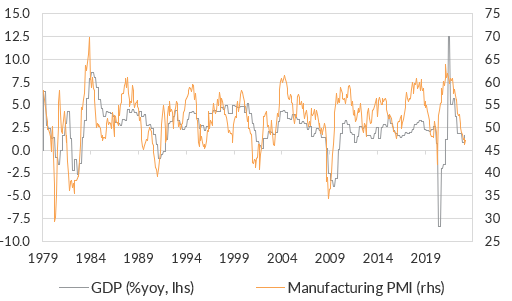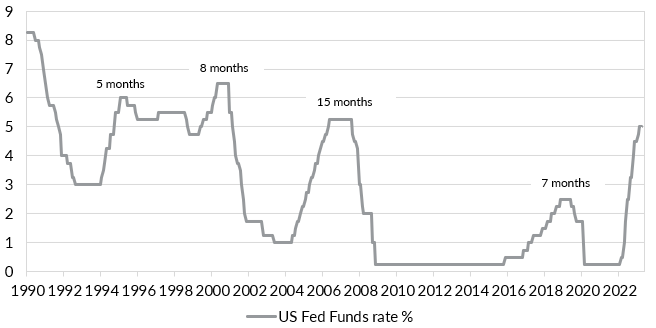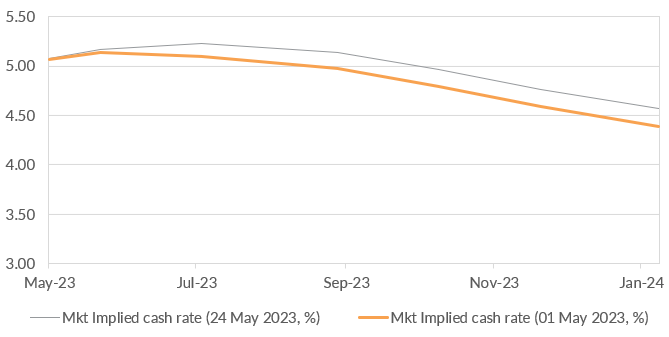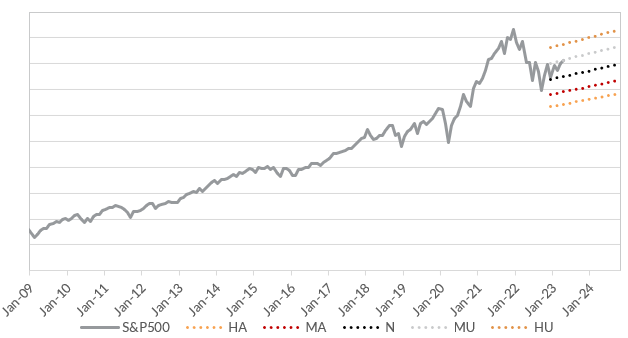5 ways to prepare your portfolio for an uncertain interest rate path
Pause, skip, or hike? The near-term pathway for the US Federal Reserve is unusually uncertain at the moment. Fed speakers have been useful in reducing the likelihood of near-term cuts. Markets have listened and are now approximately 50% priced for a June hike. The backdrop is one of aggressive rate hikes, rear-view mirror economic strength, and resilient equity markets. In this wire, we consider some plausible scenarios and what action investors can take to manage the risks in the outlook.
Three scenarios for the near-term
In the near-term, there are three plausible scenarios: 1) pause, 2) skip, and 3) hike. In the first, the Fed pauses from June and leaves rates elevated for a period. In the second, the Fed pauses in June but is forced to hike rates again after a couple of months. In the third, the Fed hikes again in June and pauses in Q3, leaving rates elevated for a period.
The ability to navigate the three plausible near-term scenarios is impacted by the debt ceiling negotiations. But if the debt ceiling is not passed, the Fed will not be hiking again. So, let’s assume for now that there is a resolution.
Table 1: Three scenarios for the US Fed.

All of these scenarios involve growth slowing. Why? Growth is already below trend. Rates are already restrictive. Another rate hike increases the risk of recession.
Chart 1: Growth is already below trend with the manufacturing PMI sub-50.

The “pause” and “hike” scenarios involve inflation continuing to trend lower. In the “hike” scenario, I have included a risk of deflation. This is because another hike risks being a policy error that drives a recession on the economy sooner.
All roads lead to rate cuts, eventually.
The Fed has repeatedly indicated it is not close to cutting rates yet. I agree. Historically, it has taken somewhere around five to fifteen months for the Fed to begin cutting after it ends a rate hike cycle.
Chart 2: The Fed usually starts cutting five to fifteen months after it stops hiking.

I don’t know when the Fed will begin cutting, but I shared in a previous wire some indicators that are useful to monitor for the end of the cycle.
Yields are moving lower in two of the scenarios.
US Treasury markets will begin to price rate cuts in well ahead of the actual cuts. We can see it already in the market pricing.
Chart 3: The market is already priced for rate cuts.

Each of the scenarios is likely to exacerbate pricing for rate cuts. Shorter-dated Treasuries should rally. This may sound counterintuitive for the “hike” scenario. And yes, yields might pop higher on the day of the announcement. But a hike now compounds the risk of Fed policy error. And that could lead markets to price steeper rate cuts over the coming 12 months.
The key scenario to watch here is the “skip” scenario. I expect the Fed will only resume rate hikes if inflationary pressures meaningfully increase. That would signal potential stagflation. And in that case, US Treasuries could sell-off with yields re-testing the peaks from 2022. Not a good scenario for sovereign bond investors.
Table 2: Near-term and medium-term impact on US Treasuries.
For equities, beware the near-term vs medium-term.
A pause from the Fed, even in the “skip” scenario, would likely be supportive of equities. Growth equities in particular could rally as yields fall. A hike, on the other hand, is probably not fully priced and could lead to equity market volatility.
It is difficult to construct a medium-term scenario where equities perform particularly well. The chart below shows our current valuation for equities is moderately overvalued. That is, equities are meaningfully above our estimate of fair value and in the moderately unattractive range.
Chart 4: US equities are already meaningfully above fair value.

And earnings growth is slowing rapidly. The Fed has limited scope (or desire) to avoid an earnings recession by cutting rates. If rates are cut, it means we are in recession. That is bad news for equities that already have a long way to correct to fair value.
Table 3: Near-term and medium-term impact on US equities.

Position portfolios for protection.
The three scenarios above highlight some of the tensions between the near-term and medium-term. I think the upside risk in the near-term for equities is more than offset by the medium-term downside risks. It is sensible to be somewhat defensive right now.
Investors can consider portfolio adjustments to protect against these risks. These include:
1) Consider increasing exposure to US Treasuries as yields move higher. Locking in higher yields offers income, but also downside protection.
2) Allocate to shorter-dated US Treasuries to reduce interest rate risk from the “skip” stagflation scenario.
3) Underweight stocks relative to “strategic” portfolio weightings, to protect against the medium-term downside risk.
4) For investors that rely predominately on a strategic asset allocation rather than dynamic, consider reducing exposure to growth stocks as prices rally in the near-term. This locks in recent strong returns and reduces sensitivity to higher bond yields in the “skip” scenario.
5) Consider allocating exposure to a “quality” bias in equities. This retains some equity beta in the “pause” and “skip” scenarios, but provides some defensiveness against the medium-term downside risks.
The above actions could help mitigate the growing risks from elevated monetary policy, while allowing some exposure to any near-term upside. Overall, I think the bias should be towards defensiveness as protecting capital now will be important given the medium-term risk.
3 topics


